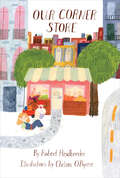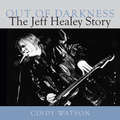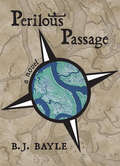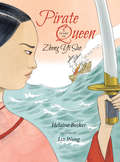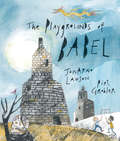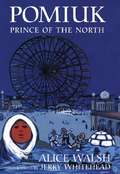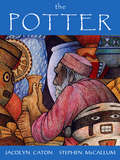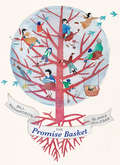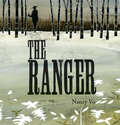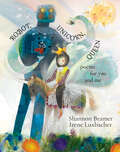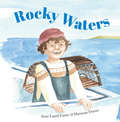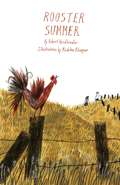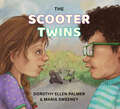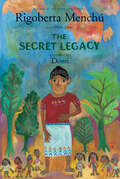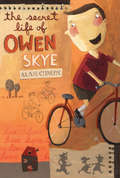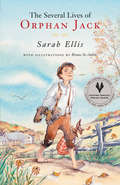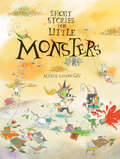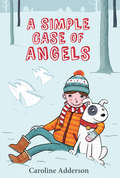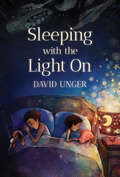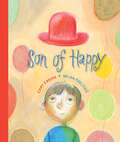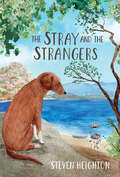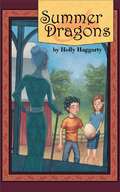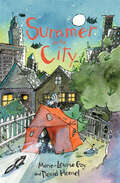- Table View
- List View
Our Corner Store
by Robert HeidbrederThis delightful novel in verse follows the adventures of a brother and sister around the neighborhood, and especially at the corner grocery store! Race you to our corner grocery store!Stanstones’ corner store is the heart of the neighborhood for the brother and sister in this story. They help to close the store every Saturday and save their pennies to buy candy. The store is the source of many adventures, where they spend a memorably spooky Halloween, play tricks on Mr. and Mrs. Stanstones, and form a search party to find Toby the store cat when he goes missing. What will happen to their beloved corner store when a brand-new supermarket opens up in town? Full of humor and playful language, this novel in verse is a sweetly nostalgic celebration of a time when children had more freedom and a mom-and-pop corner store might be the center of a kid’s world. Based on Robert Heidbreder’s childhood, this follow-up to Rooster Summer can be read as a sequel or a stand-alone story. Chelsea O’Byrne’s vibrant illustrations bring the corner store and its colorful cast of characters to life. Correlates to the Common Core State Standards in English Language Arts: CCSS.ELA-LITERACY.RL.2.4 Describe how words and phrases (e.g., regular beats, alliteration, rhymes, repeated lines) supply rhythm and meaning in a story, poem, or song.
Our Little Kitchen
by Jillian TamakiA picture book about a lively evening in a community kitchen from Governor General’s Award–winning author and illustrator Jillian Tamaki. Tie on your apron! Roll up your sleeves! Pans are out, oven is hot. The kitchen’s all ready, Where do we start?In this lively, rousing picture book from Caldecott Honoree Jillian Tamaki, a crew of resourceful neighbours come together to prepare a meal for their community. With a garden full of produce, a joyfully chaotic kitchen and a friendly meal shared at the table, Our Little Kitchen is a celebration of full bellies and people looking out for one another. Includes two recipes and an author’s note about the volunteering experience that inspired the book. Key Text Features illustrated recipes author's note speech bubbles Correlates to the Common Core State Standards in English Language Arts: CCSS.ELA-LITERACY.RL.1.4 Identify words and phrases in stories or poems that suggest feelings or appeal to the senses. CCSS.ELA-LITERACY.RL.2.4 Describe how words and phrases (e.g., regular beats, alliteration, rhymes, repeated lines) supply rhythm and meaning in a story, poem, or song.
Out of Darkness: The Jeff Healey Story
by Cindy Watson<P>Short-listed for the 2011 Golden Oak Award <P>From the moment three-year-old Jeff Healey first laid a guitar across his lap in what was to become his signature style, it was clear he was no ordinary kid. <P>Losing both eyes to retinoblastoma, a rare form of cancer, opened a door to another world for Jeff, a newly adopted infant. <P>Out of darkness he created music, becoming one of the most influential blues-rock and jazz performers of our time, beginning with his first hit album, See the Light. <P> In this up-close and personal account, loaded with never-before-seen photographs, memorabilia, and intimate recollections of family, friends, and fellow musicians, we discover this unique music icon’s dynamic career, which saw him collaborate with everyone from George Harrison and Eric Clapton to B.B. King and Stevie Ray Vaughan. <P>From Jeff’s lonely start one snowy night at St. Joseph’s Hospital in Toronto to his untimely end in the same building, we come away with a potent message of empowerment and a renewed sense of hope.
An Owl at Sea
by Susan Vande GriekThe extraordinary, true story of an owl stranded on the deck of an oil rig one hundred miles from shore, and the Good Samaritans who shepherded it home.This is the true story of a Short-eared Owl that plummeted onto the deck of an oil rig in the North Sea, one hundred miles from shore. Weak and tired, it huddled on the deck until riggers provided it with a makeshift shelter and fresh meat to eat. When a helicopter arrived to transport some of the workers back home, they took the owl with them, handing it over to the Scottish SPCA. A few weeks later the owl was strong enough to be released into the countryside.Susan Vande Griek’s gentle prose poem describes this unusual encounter with a creature from the wild with curiosity and wonder. Ian Wallace’s stunning watercolors show gorgeous seascapes, the subtle beauty of the owl, and the oil rig and its workers, creating compelling visual contrasts.An author’s note includes information about the Short-eared Owl, a bird found in the Americas, Europe and Asia, whose numbers may be in decline due to loss of habitat.Key Text Featuresauthor’s notefurther readingsourcesCorrelates to the Common Core State Standards in English Language Arts:CCSS.ELA-LITERACY.RL.1.2Retell stories, including key details, and demonstrate understanding of their central message or lesson.CCSS.ELA-LITERACY.RL.1.4Identify words and phrases in stories or poems that suggest feelings or appeal to the senses.CCSS.ELA-LITERACY.RL.1.5Explain major differences between books that tell stories and books that give information, drawing on a wide reading of a range of text types.CCSS.ELA-LITERACY.RL.2.3Describe how characters in a story respond to major events and challenges.CCSS.ELA-LITERACY.RL.2.4Describe how words and phrases (e.g., regular beats, alliteration, rhymes, repeated lines) supply rhythm and meaning in a story, poem, or song.CCSS.ELA-LITERACY.RL.2.7Use information gained from the illustrations and words in a print or digital text to demonstrate understanding of its characters, setting, or plot.
Perilous Passage
by B. J. BayleShortlisted for the 2009 Red Maple Award and commended in Best Books for Kids & Teens After a shipwreck in 1809, Peter finds himself the victim of amnesia. The sea captain who finds the teenager gives him the only name he knows, while others derisively dub him Peter No-Name. Eventually, Peter finds employment in a Montreal tavern where he meets a French voyageur called Boulard who changes his life irrevocably. Boulard works for fur trader David Thompson, soon to become one of the world’s most famous explorers and mapmakers. Thompson is impressed with the teenager and enlists him in his obsessive quest to establish an overland "northwest" passage to the Pacific Ocean via the Columbia River. With Thompson, Peter embarks on an amazing series of adventures that brings him face to face with hostile Natives and exposes him to the hardships and life-threatening challenges of formidable mountains and primeval forests as the intrepid outdoorsmen canoe, ride, and sled across a continent still largely untouched by European civilization.
Pirate Queen: A Story of Zheng Yi Sao
by Helaine BeckerAn inspiring story of Zheng Yi Sao, the real-life pirate queen who took control of her life — and the South China seas — in the early 19th century. The most powerful pirate in history was a woman who was born into poverty in Guangzhou, China, in the late 1700s. When pirates attacked her town and the captain took a liking to her, she saw a way out. Zheng Yi Sao agreed to marry him only if she got an equal share of his business. When her husband died six years later, she took command of the fleet. Over the next decade, the pirate queen built a fleet of over 1,800 ships and 70,000 men. On land and sea, Zheng Yi Sao’s power rivaled the emperor himself. Time and again, her ships triumphed over the emperor’s ships. When she was ready to retire, Zheng Yi Sao surrendered — on her own terms, of course. Even though there was a price on her head, she was able to negotiate her freedom, living in peace and prosperity for the rest of her days. Zheng Yi Sao’s powerful story is told in lyrical prose by award-winning author Helaine Becker. Liz Wong’s colorful, engaging illustrations illuminate this inspiring woman in history. An author’s note provides historical context and outlines the challenges of researching a figure about whom little is known. Key Text Features author’s note historical context sources Correlates to the Common Core State Standards in English Language Arts: CCSS.ELA-LITERACY.RL.2.3 Describe how characters in a story respond to major events and challenges. CCSS.ELA-LITERACY.RL.4.3 Describe in depth a character, setting, or event in a story or drama, drawing on specific details in the text (e.g., a character's thoughts, words, or actions).
The Playgrounds of Babel
by JonArno LawsonFrom the international best-selling author of Sidewalk Flowers and a world-renowned illustrator, this picture book is about the power of song, inspired by the story of the Tower of Babel. This unusual, thought-provoking story begins with an old woman telling a tale to a group of children in a playground. One of the boys can’t understand what she is saying, so another offers to translate. The old woman’s tale is inspired by the Tower of Babel story: In the days when everyone spoke the same language, the people built a tower to reach God. But God was annoyed and sent a dragon to destroy the tower, then created new languages for everyone so that they couldn’t understand each other. Fortunately, two little girls find a way to communicate through song. Told entirely through dialogue, moving back and forth between the old woman’s tale and the exchange between the two boys, this original, sometimes funny story raises questions about what divides us and what brings us together, in spite of all our differences — it is the power of song in this case, which ultimately brings hope. Piet Grobler brings a masterful visual interpretation to this layered story, rendering the old woman and children in the playground in monochromatic tones and the characters in the old woman’s tale in a naïve style with vibrant color, complete with incomprehensible languages in hand-drawn speech balloons. An author’s note explains JonArno Lawson’s inspiration for the story. Key Text Features author’s note Correlates to the Common Core State Standards in English Language Arts: CCSS.ELA-LITERACY.RL.1.6 Identify who is telling the story at various points in a text. CCSS.ELA-LITERACY.RL.2.9 Compare and contrast two or more versions of the same story (e.g., Cinderella stories) by different authors or from different cultures.
Pomiuk, Prince of the North
by Alice WalshWinner of the 2005 Ann Connor Brimer Award, short-listed for the 2006 Hackmatack Award The year is 1893, the place is Chicago, and the most fabulous fair the Earth has ever seen becomes an unusual home for a young Labrador Inuit boy dubbed Pomiuk, Prince of the North, who captures the hearts of the millions of people who click through the turnstiles to see Eskimo Village, one of dozens of living cultures showcased at the exhibition. Just as he did so long ago, Pomiuk’s adventures will once again charm and enthrall all those who come his way.
The Potter
by Jacolyn CatonThe timeless story of a magical maker of pots who lived at the edge of an ancient, sinking island. One day, the potter begins to build a magnificant blue palace of clay that glistens in the sun. The villagers are amazed and become suspicious of the foolish old potter. They conspire to possess the palace and throw the potter back into the sea. But the pots are listening and warn the potter of coming treachery. Recommended reading ages 6-8
The Promise Basket
by Bill RichardsonFrom award winning author Bill Richardson and highly acclaimed illustrator Slavka Kolesar comes a beautiful story about the love between a mother and daughter where a promise makes the perfect gift.A stone when it’s thrown can damage, can break,but nothing can shatter the promise I make.So begins the poem a mother writes on a scrap of paper. She wraps the paper around a stone and places it in a basket to give to her daughter on her first birthday. They are poor, but the mother is determined that gifts will be given when gifts need giving. She keeps her promise, and the Promise Basket, too.Every time there is a need for gifts, the mother finds a pretty stone to tie up with paper and ribbon, and gives it to her daughter in the basket. She continues the tradition over the years until her daughter has a baby of her own…The love between a mother and her daughter is celebrated in this lyrical story from Bill Richardson, featuring colorful illustrations by Slavka Kolesar.Correlates to the Common Core State Standards in English Language Arts:CCSS.ELA-LITERACY.RL.2.5Describe the overall structure of a story, including describing how the beginning introduces the story and the ending concludes the action.CCSS.ELA-LITERACY.RL.4.2Determine a theme of a story, drama, or poem from details in the text; summarize the text.
The Ranger (The Crow Stories Trilogy #2)
by Nancy VoIn this second book in Nancy Vo’s Crow Stories trilogy, a ranger and a fox form a special and unexpected friendship while navigating an indifferent and dangerous wilderness. In this memorable and beautifully illustrated story, a ranger comes across a fox caught in a trap. The ranger frees the fox and promises only to tend to its wounds. The fox recovers and remains curiously close to the ranger, and when unexpected twists occur, the fox ends up being the helper. The ranger asks the fox, “Does this make us even?” and almost immediately feels regret—keeping score has no place in friendship. And so the two continue their journey together. In this second book in the Crow Stories trilogy, Nancy Vo explores themes of friendship and how meaningful bonds form when we can openly give and receive. Vo’s stunning, spare illustrations are a delight, and complement the journey of these two nuanced characters toward understanding and companionship. Correlates to the Common Core State Standards in English Language Arts: CCSS.ELA-LITERACY.RL.1.2 Retell stories, including key details, and demonstrate understanding of their central message or lesson.
Robot, Unicorn, Queen
by Shannon BramerA collection of poems that explore childhood experiences—from the whimsical to the poignant—by Shannon Bramer, with magical art by Irene Luxbacher. Shannon Bramer’s follow-up to her much-loved poetry book Climbing Shadows is a collection of poems that explore a range of childhood experiences. Many poems reveal what it feels like to be a child—to pretend and dream and play with abandon, as well as to hurt and regret and feel sorrowful. The poems are varied in form, and while some are simple and direct, others invite children to see the potential for play and discovery in words and language. In the opening poem a child welcomes their newborn sibling, while the last poem is a surreal lullaby. In between we find poems about a child who listens to a toad, who feels left out, who loves the beach, who must practice piano, who accidentally breaks their mother’s favorite plate, who doesn’t want to eat their lunch, whose pet budgies have died, who visits their father on weekends, and more. Readers young and old will see themselves in these beautifully illustrated poems—a collection full of laughter, tears and wonder. Key Text Features author’s note Illustrations poems table of contents writing inspiration Correlates to the Common Core State Standards in English Language Arts: CCSS.ELA-LITERACY.RL.4.2 Determine a theme of a story, drama, or poem from details in the text; summarize the text.
Rocky Waters
by Anne Laurel CarterInspired by a true story, Rocky Waters is about a young boy who wants nothing more than to fish for lobster with his dad. All day at school, Rocky stares out the window, imagining fishing boats sailing across the sky. He wants nothing more than to fish for lobster with his dad, and finally one season he’s old enough to go along. Before dawn, Rocky, Dad and sister Patsy untie their boat and head out to sea. Surrounded by the vast expanse of sky and water, Rocky feels as free as a seagull. His dad steers toward their first buoy, then pulls up a line of traps full of lobster. Rocky learns how to band their claws, then Patsy rebaits the traps and shoves them back into the sea. It takes a full day to haul up, empty, rebait and re-set three hundred traps, but Rocky loves every minute of it. “If the salt’s still in your veins when you’re Patsy’s age, you can leave school and fish all you want,” his dad tells him. Anne Laurel Carter’s story is inspired by the childhood memories of Rocky Gaudet, who grew up wanting to fish the sea like his Acadian ancestors. He continues to fish for lobster in Prince Edward Island and Nova Scotia today. Marianne Dumas’ naïve watercolor illustrations recall Rocky’s first fishing experience. Key Text Features author’s note glossary Correlates to the Common Core State Standards in English Language Arts: CCSS.ELA-LITERACY.RL.K.3 With prompting and support, identify characters, settings, and major events in a story. CCSS.ELA-LITERACY.RL.3.3 Describe characters in a story (e.g., their traits, motivations, or feelings) and explain how their actions contribute to the sequence of events
Rooster Summer
by Robert HeidbrederSpend a rooster summer on the farm with these irresistible read-aloud poems. For the brother and sister in this novel in verse, each day begins with a barnyard wakeup call. During a summer spent on their grandparents’ farm, they collect eggs from the chicken coop, put on shows for city folks in passing trains, fill in for the farm dog by barking the cows home and dance around the perfectly ripening watermelon growing in Grandma’s garden. All of these barnyard adventures happen in the company of Rexter the rooster, Seed-Sack the mule and Ginger-Tea the farm dog — animal friends that will steal readers’ hearts over the course of a carefree rooster summer.Based on award-winning poet Robert Heidbreder’s childhood, these irresistible read-aloud poems show the tender relationship between children and their grandparents. Madeline Kloepper brings the cast of lovable human and animal characters to life with her vintage art style. This early novel in verse about the simple joys of childhood on a farm is nostalgic yet timeless.Key Text Featurespoemsillustrationsheadingstable of contentsCorrelates to the Common Core State Standards in English Language Arts:CCSS.ELA-LITERACY.RL.1.3Describe characters, settings, and major events in a story, using key details.CCSS.ELA-LITERACY.RL.2.4Describe how words and phrases (e.g., regular beats, alliteration, rhymes, repeated lines) supply rhythm and meaning in a story, poem, or song.
The Scooter Twins
by Dorothy Ellen PalmerMelanie and Melvin may be twins, but they couldn’t be more different. Melanie is LOUD and Melvin is quiet. Melvin likes frogs and Melanie loves MOTORCYCLES! When the twins learn that they will get their very own mobility scooters, Melanie is excited to race to school, but Melvin is worried he’ll fall — and that people will stare. And there’s a problem: Grandma can’t afford the scooters without selling one of Mom’s treasured paintings, one of the only things the twins have left to remember their parents. In the process of getting their scooters, Melanie and Melvin have to navigate challenges that people with disabilities face on a daily basis: rudeness from a store clerk and products that aren’t made with kids in mind. But in the end, Melanie and Melvin choose scooters that are just right for them and make moving through their neighborhood a new adventure. Written by disability advocate and mobility scooter user Dorothy Ellen Palmer, and illustrated by Maria Sweeney, The Scooter Twins is an #ownvoices story that shares the joys and challenges of disabled childhood, and offers many kids who get new wheels the opportunity to find themselves in the pages of a book. Key Text Features illustrations Correlates to the Common Core States Standards in English Language Arts: CCSS.ELA-LITERACY.RL.2.3 Describe how characters in a story respond to major events and challenges. CCSS.ELA-LITERACY.RL.4.3 Describe in depth a character, setting, or event in a story or drama, drawing on specific details in the text (e.g., a character's thoughts, words, or actions).
The Secret Legacy
by Rigoberta Menchú Dante LianoNobel Peace Prize winner and noted Maya activist Rigoberta Menchú Tum returns once more to the world of her childhood in The Secret Legacy. Seven-year-old Ixkem is chosen by her grandfather amongst all the villagers to inherit the responsibility for tending his special cornfield. Ixkem goes to the field and begins to shout and stomp to frighten away the animals who would like to share the harvest. Suddenly a mass of tiny creatures appear — the b'e'n — secret animal spirits of which there is one for every human on earth. They take Ixkem into the underworld, where she tells them the amazing stories that her grandfather has told her. In exchange the b'e'n whisper a secret for her to take to her grandfather. Rich and vibrant illustrations by noted Mazatec-Mexican artist Domi perfectly complement this magical Maya tale. Key Text Features Illustrations Correlates to the Common Core State Standards in English Language Arts: CCSS.ELA-LITERACY.RL.3.2 Recount stories, including fables, folktales, and myths from diverse cultures; determine the central message, lesson, or moral and explain how it is conveyed through key details in the text.
The Secret Life of Owen Skye
by Alan CumynWinner of the Mr. Christie's Book Award and the Hackmatack Children's Choice Book Award Owen Skye is skinny and quiet and has big ears. He does everything (just about) his older brother, Andy, says, while trying to stay one step ahead of little brother Leonard, who has now started school and is becoming smart at an alarming pace. The Skye brothers live in a small rural village with their parents and weird Uncle Lorne, an eccentric and painfully shy bachelor who sleeps on a cot in the basement, takes out his teeth at night and embodies Owen's worst fears about becoming a grownup. On his way home from hockey practice one evening, Owen catches a glimpse of a girl named Sylvia at her piano lesson, and he falls hopelessly in love. Thank goodness for life at home, where there are brothers to talk to and plot adventures with. Yet the Skye boys somehow have a knack for turning every innocent plan into a full-scale ordeal.
The Several Lives of Orphan Jack
by Sarah EllisWinner of the Mr. Christie's Book Award and the IODE Violet Downey Book Award For young Jack, life is tough at the Opportunities School for Orphans. But Jack is good at staying out of trouble. He has skipped over trouble, danced around trouble, slid under trouble, melted away from trouble, talked his way out of trouble and slipped between two close troubles like a cat through a picket fence. When Jack turns twelve, he is given the biggest opportunity of all, but suddenly his life is nothing but trouble. Still, he is a clever and resilient boy, and eventually he makes his way into the big world. Jack is rich in ideas, and soon he finds there is a place for an enterprising boy who has whims, concepts, plans, opinions, impressions, notions and fancies to spare. In the tradition of Natalie Babbitt, Sarah Ellis brings her quirky sense of humor and imagination to bear in this witty, warm fable. Bruno St-Aubin's evocative black-and-white illustrations capture perfectly the dreadful Schoolmaster Bane, the crowlike accountant Mr. Ledger, Lou the skinny bun merchant, and Christabel, the miller's little daughter.
Short Stories for Little Monsters
by Marie-Louise GayThe internationally acclaimed author of the Stella and Sam series has created a collection of short, funny illustrated stories.This hilarious collection of illustrated stories gives us a glimpse into the things children wonder about every day.What do cats really see? What do trees talk about? Should you make funny faces on a windy day? Do worms rule the world? Do mothers always tell the truth? Do snails have nightmares?These short stories are illustrated in vibrant watercolor and collage in cartoon style. They are rich in detail and tiny humorous subplots that will delight all little sharp-eyed monsters.Key Text Featureshumourspeech bubblespanelsCorrelates to the Common Core State Standards in English Language Arts: CCSS.ELA-LITERACY.RL.K.5Recognize common types of texts (e.g., storybooks, poems).CCSS.ELA-LITERACY.RL.K.7With prompting and support, describe the relationship between illustrations and the story in which they appear (e.g., what moment in a story an illustration depicts).CCSS.ELA-LITERACY.RL.1.7Compare and contrast two or more characters, settings, or events in a story or drama, drawing on specific details in the text (e.g., how characters interact).CCSS.ELA-LITERACY.RL.2.7Use information gained from the illustrations and words in a print or digital text to demonstrate understanding of its characters, setting, or plot.CCSS.ELA-LITERACY.RL.3.7Explain how specific aspects of a text's illustrations contribute to what is conveyed by the words in a story (e.g., create mood, emphasize aspects of a character or setting)
A Simple Case of Angels
by Caroline AddersonNicola’s adorable little dog, June Bug, keeps getting into trouble. She steals the neighbor’s turkey, yanks down the Christmas tree and destroys Mum’s almost-finished giant crossword. Everyone is mad, and it looks as though June Bug’s days are numbered.Will doing a good deed make up for June Bug’s bad behavior?Nicola certainly hopes so. And when she and June Bug come across a new nursing home in the neighborhood, it feels like a Sign. They volunteer to become regular visitors at Shady Oaks, certain that June Bug’s cute tricks will cheer up the elderly residents.In fact, they could all use some cheering up. It’s the holiday, and yet everyone seems to be cranky and off balance. Nobody has put up any lights, Nicola’s grade five teacher is inexplicably crabby, and Nicola’s big brother Jared stays holed up in front of the computer playing Inferno 2, eagerly sending winged creatures into a fiery abyss. Even Nicola is not herself, and when a new girl, Lindsay, tries to be her friend, Nicola finds herself being uncharacteristically mean, because Lindsay seems to be one of those hair-and-jewelry girls who wants her own subscription to Bride magazine for Christmas.But Nicola’s mother won’t let her visit Shady Oaks by herself, so when Lindsay offers to go with her, Nicola agrees. And the girls discover that something unusual is going on at the home, where it seems that a few of the more remarkable patients are being kept against their will. Freeing them will bring out the very best in Nicola, and especially in June Bug.
Sleeping with the Light On
by David UngerLife in Guatemala is simple for young Davico and his older brother Felipe ... until soldiers invade, and the blackouts begin. Davico lives with his family above La Casita — the Little House — in Guatemala City in the early 1950s. But it’s not just a little house. It’s also the family restaurant! The restaurant provides plenty of distraction and adventure for Davico and his older brother, Felipe. The mean cook, Augusto, and the always-late waiter, Otto, love to play tricks on Davico. There’s a huge oven that Felipe knows how to light — if he can only reach the box of matches above the stove. And don’t forget the glass tank of live lobsters — including the king of them all, Genghis Khan, who stares at Davico with round unblinking eyes. Could Genghis Khan climb on the back of the other lobsters and get out of the tank, Davico wonders. Could he move faster on land than in the water? Then one day, Davico hears shooting in the streets. There are blackouts every evening, and the family must sleep under the big wooden table in the dining room. People stop coming to the restaurant, and tanks and soldiers swarm the front of the National Palace, where a shoeshine boy warns the brothers that the gringos are coming. But what does that mean, and who are the gringos? Davico wants to be brave, but the shooting and tanks and airplanes flying overhead terrify him. He finds comfort in the special lamp that his father buys him to endure the blackouts. But it is not enough to console Davico when his parents announce that it’s time to leave for the United States of America, where no one speaks Spanish, and everything is different. Key Text Features Illustrations Correlates to the Common Core State Standards in English Language Arts: CCSS.ELA-LITERACY.RL.3.7 Explain how specific aspects of a text's illustrations contribute to what is conveyed by the words in a story (e.g., create mood, emphasize aspects of a character or setting)
Son of Happy
by Cary FaganHow would you feel if your dad were a clown? The boy in this story never wants to go to his friends’ birthday parties, because Happy the Clown is always there. And Happy is … his dad. He wishes his dad had a regular job, like all the other kids’ parents. He didn’t mind his dad being a clown when he was a little kid, but now it’s just embarrassing. And even worse, since business is slow, his dad is putting a sign on the front lawn advertising his clown services! But one night at dinner Dad announces that he’s going back to his old job of being a lawyer. “You were a lawyer?” the boy asks, incredulous. Now his dad wears a suit and tie to work, the family can buy a new car, his mom can take piano lessons, and he can have a skateboard and cellphone. But something feels different. The boy wonders if his dad misses being a clown. Or is he the one who misses Happy? With bittersweet humor, Cary Fagan brings us a story about a boy’s growing consciousness and a father’s realization that he can be himself. Key Text Features speech bubbles Correlates to the Common Core State Standards in English Language Arts: CCSS.ELA-LITERACY.RL.4.3 Describe in depth a character, setting, or event in a story or drama, drawing on specific details in the text (e.g., a character's thoughts, words, or actions).
The Stray and the Strangers
by Steven HeightonBased on a true story, a stray dog befriends an orphan boy in a refugee camp on a Greek island. The fishermen on Lesvos call her Kanella because of her cinnamon color. She’s a scrawny, nervous stray — easily intimidated by the harbor cats and the other dogs that compete for handouts on the pier. One spring day a dinghy filled with weary, desperate strangers comes to shore. Other boats follow, laden with refugees who are homeless and hungry. Kanella knows what that is like, and she follows them as they are taken to a makeshift refugee camp. There she comes to trust a bearded man, an aid worker, and gradually settles into a contented routine. Kanella grows healthy and confident. She has a job now — to keep watch over the people in her camp. One day, a little boy arrives and does not leave like the others. He seems to have no family and, like Kanella, he is taken in by the workers. He sleeps on a cot in the food hut, and Kanella keeps him warm and calm. When two new adults come to the camp. Kanella is ready to defend the boy from them, until she is pulled away by the bearded man. They are the boy’s parents, and now he must go with them. Eventually, the camp is dismantled, and Kanella finds herself homeless again. Until one night, huddled in the cold, she awakens to see two bright lights shining in her eyes — the headlights of a car. The bearded man has come back for her, and soon Kanella is on a journey, too, to a new home of her own. Key Text Features maps illustrations author's note Correlates to the Common Core State Standards in English Language Arts: CCSS.ELA-LITERACY.RL.5.6 Describe how a narrator's or speaker's point of view influences how events are described.
Summer Dragons
by Holly HaggartyTen-year-old Elizabeth is spending the summer at her Great-Aunt Germaines, in rural Caradoc County. Also along for the visit is her brother, Eddie, and her mother. Great-Aunt Germaine seems to be a forbidding character, and Beth does not warm up to her. Between her relationship with Aunt Germaine and Eddies antics, Elizabeth feels overwhelmed. She discovers her aunts emporium, a former tourist attraction. It is a fascinating place, filled with memorabilia, including old newspaper reports of a mysterious swamp monster. Elizabeths own adventure begins when she finds a perfectly egg-shaped stone in the local graveyard. Its brilliantly white, warm, and pulsing with energy and it feels like theres something inside. Encouraged by her eccentric great-aunt, Beth builds a nest for the egg stone. When the egg hatches, Elizabeths imagination guides her in a fantastical search for the runaway hatchling. Her investigations, abetted by her great-aunt, lead her to believe that the hatchling is the legendary Caradoc Swamp Monster. Elizabeths efforts to prove her deductions bring her into ever more fiery conflict with Eddie. What hatches is a zany adventure involving quick mud, skunk cabbage, swamp monsters, dragon dives, bonfires, fiery words and broiling tempers. Its a summer of dragons. The solution to both the mystery of the egg stone and the problem of sibling rivalry are satisfyingly reached in the humorous and imaginative conclusion of Summer Dragons.
Summer in the City (Travels with My Family)
by Marie-Louise Gay David HomelHusband-and-wife team Marie-Louise Gay and David Homel create a sequel to the enormously popular Travels with My Family and On the Road Again! — but with a twist. This time Charlie and his family stay home, and find adventure in their own Montreal neighborhood. Charlie can’t wait for school to be over. But he’s wondering what particular vacation ordeal his parents have lined up for the family this summer. Canoeing with alligators in Okefenokee? Getting caught in the middle of a revolutionary shootout in Mexico? Or perhaps another trip abroad? Turns out, this summer the family is staying put, in their hometown. Montreal, Canada. A “staycation,” his parents call it. Charlie is doubtful at first but, ever resourceful, decides that there may be adventures and profit to be had in his own neighborhood. And there are. A campout in the backyard brings him in contact with more than one kind of wildlife, a sudden summer storm floods the expressway, various pet-sitting gigs turn almost-disastrous, and a baseball game goes awry when various intruders storm the infield — from would-be medieval knights and an over-eager ice-cream vendor to a fly-ball-catching Doberman. Then of course there’s looking after his little brother, Max, who is always a catastrophe-in-the-making. Key Text Features illustrations key text features Correlates to the Common Core State Standards in English Language Arts: CCSS.ELA-LITERACY.RL.2.5 Describe the overall structure of a story, including describing how the beginning introduces the story and the ending concludes the action. CCSS.ELA-LITERACY.RL.3.3 Describe characters in a story (e.g., their traits, motivations, or feelings) and explain how their actions contribute to the sequence of events. CCSS.ELA-LITERACY.RL.3.9 Compare and contrast the themes, settings, and plots of stories written by the same author about the same or similar characters (e.g., in books from a series). CCSS.ELA-LITERACY.RL.5.5 Explain how a series of chapters, scenes, or stanzas fits together to provide the overall structure of a particular story, drama, or poem. CCSS.ELA-LITERACY.RL.5.6 Describe how a narrator's or speaker's point of view influences how events are described.
